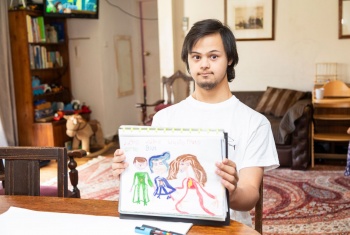Doomadgee NDIS participant and local indigenous artist, Barry Johnny, is back painting after a stroke halted his creativity, but he’s grateful regular supports have him back doing what he loves best and well on the road to recovery.
Barry, 54, said after having a stroke three years ago, and being flown from Doomadgee to Townsville for lifesaving treatment, he woke up in hospital with significant memory loss.
A highly regarded indigenous artist with hundreds of paintings and exhibited works whose sales formed part of his income, Barry said his life changed dramatically in an instant.
“When I returned home I didn’t paint because I couldn’t remember a lot of the animals’ names I’d painted… goanna, crocodile, Barramundi, and I couldn’t remember people’s names, but now I have support, I’m back painting and I’m starting to remember,” he said.
My Pathway program coordinator, Lee Brown, part of the remote disability support provider team assisting Barry, said he’s doing a stellar job with his recovery.
“Barry attends two one-hour speech therapy sessions a week, with his indigenous support worker, Robina, who sits beside him, prompting him if he gets stuck on his words,” he said.
“Robina also helps Barry during the week with jobs around his house and she gets him out into the community. Robina is an important part of Barry’s recovery, keeping him on track.”
Lee said My Pathway has a great relationship with James Cook University, so Barry is doing his speech therapy sessions with its speech pathology students via telehealth.
“Barry’s working with a really nice guy, Callum, who he gets along with. At each session Callum asks Barry to bring in a different painting so they can talk about it.
“These sessions are really making a difference. Barry loves talking about all his paintings. He has about 40 on the go in his room at the moment. It’s a great way to make him think about all his artwork and it encourages him to use his words.
“Callum also gets Barry to figure out what colour combinations go together, and asks him about all the shapes and techniques he uses in a process aimed at repairing the connections in his brain damaged by the stroke.
“Now Barry’s starting to remember more about his country and community, we can see he’s so much happier.
“The therapy and support he gets is also helping him to rebuild his confidence and it has done wonders, reconnecting him to community.”
Lee said when Barry arrived home after his stroke he was a bit of a recluse. “He wasn’t mixing with his community. He just stayed home. It was his safe place, but now he visits our office most mornings.
“He also likes to have a yarn to all the guys welding and doing carpentry in our Pathway shed,” Lee said.
“The welders are making vases at the moment, so they’ve asked Barry and another participant, Beau, to paint them.
“Barry’s looking forward to it, so it’s another activity we can support him with.”
Lee said for Barry, and others, getting to paint, weld and do carpentry together not only gives participants and their support workers a way to connect, it also gives them the opportunity to yarn, reminisce, plan future catch-ups and enjoy being together as a group.
“This way art becomes more than an activity. It’s a way of continuing to involve people in their community, which is really important for them culturally and spiritually,” he said.



